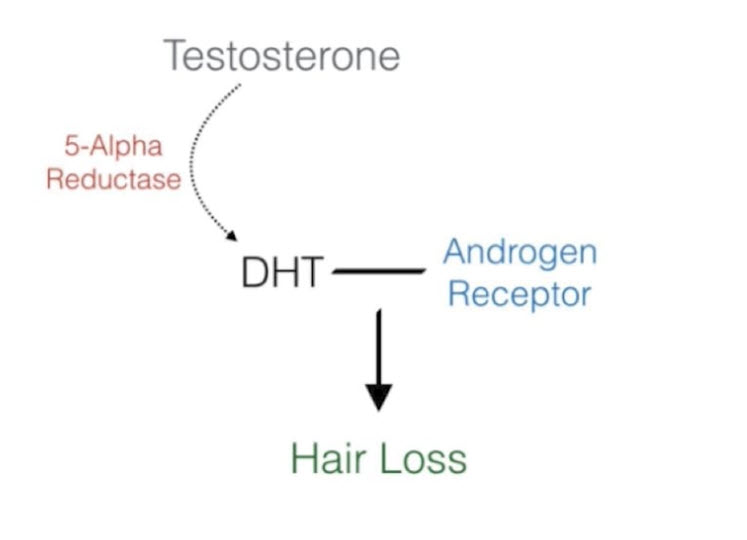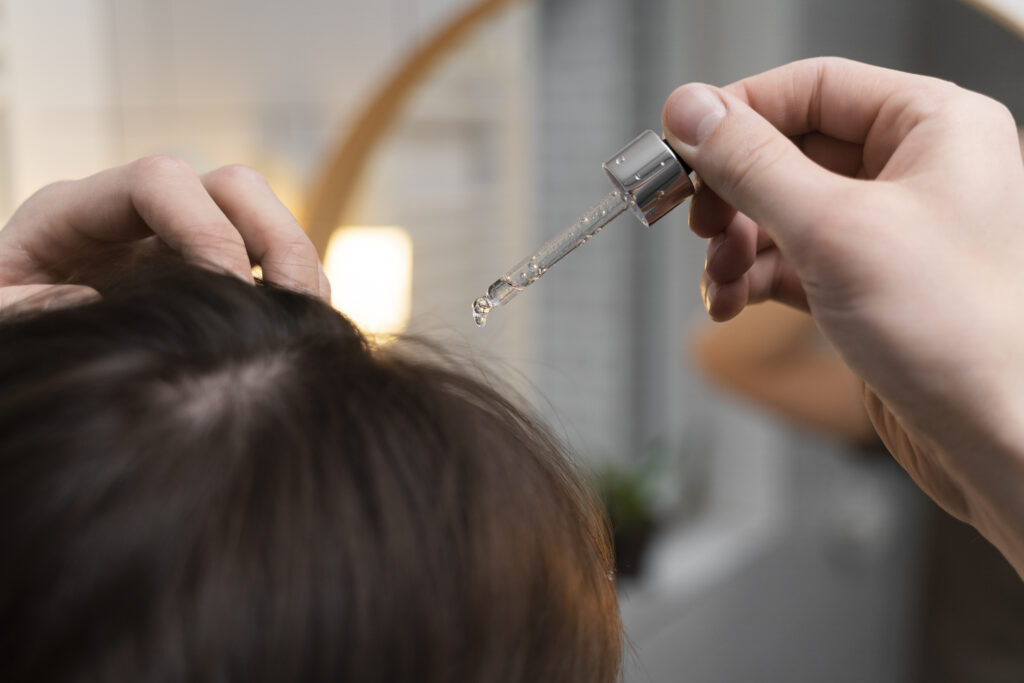People are often concerned with thinning hair and receding hairlines. DHT might be the culprit in many cases. This blog will explore how this hormone can harm hair health.
What is the role of the DHT hormone in hair loss? You might be concerned about how this hormone can lead to hair loss and how this challenge can be fixed. This post will take an educational approach to explaining the challenge and its remedy.
What is DHT and Why Does It Matter?
DHT, or Dihydrotestosterone hormone, is released as a testosterone byproduct. It has a significant role to play in puberty and stimulates the Y chromosome to lead to male traits, such as a deeper voice, increased body hair and muscle mass, and growth in the penis, testicles, and scrotum with the beginning of sperm production.
However, an excess of this hormone can lead to the shrinking of hair follicles, and leading to hair loss. Thus, a common case of hair loss is caused by DHT thinning hair.
How DHT Affects Hair Follicles
Does DHT cause hair loss? From the previous section, it can be inferred that it does. But how does it
do so? About 10% of testosterone in all adults is converted into DHT, with the help of an enzyme referred to as 5-alpha reductase. And once it is free-flowing in your scalp, receptors are linked to your follicles, leading to shrinkage.

It is also a leading cause of thinning hair. It leads to thicker and longer hair becoming finer and shorter. And with time, it can also lead to some hair follicles being dormant, leading to visible hair loss.
Here is a short comparison between the healthy hair cycle and the DHT-affected hair cycle:
| Factors | Healthy Hair Cycle | DHT-affected Hair Cycle |
| Growth phase | Active hair growth from follicles. | It binds to follicles and shrinks them, leading to reduced hair growth. |
| Transition and resting phases | Growth slows, the follicle shrinks, and hair is shed before regrowth. | Hair grows for a shorter period, and shrunken follicles lead to hair thinning quickly. |
| Hair features | Hair is shiny, fully-grown, and not easily tangled. | Thinning and oily hair. Receding hairline. |
Table 1: Healthy vs. DHT hair cycle
Who is Most Affected by DHT-related Hair Loss?
Both men and women are affected by DHT-related hair loss, however in different ways. The following table explores these:
| Effect of DHT on Men | Effect of DHT on Women |
| A thinning crown Receding hairline Male pattern baldness | General thinning Thinning hair on top of the scalp Female pattern hair loss |
Table 2: Effect of DHT on Men vs. Women
Thus, in men, DHT and baldness are closely interlinked. However, for women, hair thinning is a more common impact compared to hair loss.
DHT and Androgenetic Alopecia (Pattern Baldness)
In the last section, the concept of pattern baldness or pattern hair loss has been touched upon. This concept of pattern baldness is more scientifically referred to as alopecia. And, when it affects both men and women, it is referred to as androgenetic alopecia.
DHT is a common cause of androgenetic alopecia, or male pattern baldness. And androgenetic alopecia is the most common cause of hair loss for men and women.
While DHT sensitivity is commonly hereditary, it does not affect everyone equally. The most common example of this is how men and women react to it differently.
For men, it is most commonly associated with balding and a receding hairline. However, for women, it is mostly associated with thinning hair in areas near the scalp.
Factors That Influence DHT Impact
There are different factors that impact how DHT affects hair in a person. Here is a multi-factor table discussing the key factors:
| Factor | Impact |
| Advancing age | Increase in DHT sensitivity. |
| Hormonal fluctuations | Imbalance in testosterone production and DHT. |
| Stress level and lifestyle | A direct impact on DHT levels and receptor activities. |
| Scalp health | Scalp inflammation can worsen the follicle condition. |
Table 3: Factors Influencing DHT Impact
There is a great video by Dr. Parsa Mohebi that explains just how testosterone affects hair growth, and loss.
FDA-Approved Medical Treatments
So, if the hormone is so harmful to hair life, is there any treatment to consider? Actually, there are FDA-approved medical treatments that focus on how to combat DHT. There are two key examples of this form of medication:
Finasteride or Propecia
It is a type of oral medication that inhibits the Type II 5-alpha reductase. This enzyme converts testosterone into DHT. Thus, by inhibiting 5-alpha reductase, DHT formation is stalled, protecting hair health. And, it can reduce this conversion by up to 70%.
Note: If you want to start this treatment, you need a prescription. This is because there is a chance of side effects among a small percentage of users.
Dutasteride
Dutasteride can inhibit both Type I and Type II 5-alpha reductase. However, unlike the previous option, it is often recommended without a prescription as a medication for hair loss. Although the issue with this is that there are very few studies confirming its impact on hair restoration.
Here is a table depicting the difference between these two medications:
| Finasteride | Dutasteride | |
| Mechanism | Oral medication | Oral or topical medication |
| Dosage | One tablet a day (1-5mg) | One tablet a day (0.5 mg) or 0.1-0.3% in case of topical liquid solution |
| Side Effects | Reduced libido Inability to maintain an erection Pain in the testicles Depression | Allergic reaction Changes in sex drive and performance Male breast enlargement |
Table 4: Finasteride vs. Dutasteride
Natural DHT Blockers
Many people suffering from hair loss or alopecia do not prefer taking medicines. They focus instead on natural DHT blockers.
Now, what are DHT blockers? These are essentially substances that inhibit its production in the human body.
Some common examples of natural DHT blockers are:
Saw Palmetto: It is a naturally growing tree. Its fruit is used as medication. It can inhibit 5-alpha reductase naturally.
Pumpkin Seed Oil: It has anti-inflammatory effects and can help modulate hormones such as DHT.
Also, Green Tea Extract, Pygeum, Nettle Root, and Caffeine can help in this purpose.
Topical Treatments Supporting DHT Reduction
There are also topical treatments that manage how to control DHT, like shampoos and formulae. The examples that can be included here are:
- Ketoconazole shampoo: It has anti-DHT and antifungal effects.
- Caffeine-infused formulae: These formulae can block DHT at the follicle level, preventing follicle closure.
- Minoxidil (Rogaine): It can’t block DHT, but it can stimulate hair regrowth, making it ideal to use with DHT blockers.
Advanced Solutions That Address DHT Damage
In case you are looking for more advanced solutions rather than looking just oral or topical medication, here are some solutions that can support.
Platelet-Rich Plasma Therapy
PRP therapy includes injections where your own growth-factor-rich plasma is injected into your scalp. This way, the blood flow to your hair follicles increases, preventing any shrinkage in them. So, when used with DHT blockers, they offer the best results.
Hair Transplant Surgery
There are two types of hair transplant surgery that you can consider. The Follicular Unit Extraction (FUE) and the Follicular Unit Transplantation (FUT). FUE hair transplant involves the grafting of individual units of hair follicles, both from a safe area and the affected area. FUT hair transplant involves harvesting a strip of skin from a safe portion and then dissected into individual healthy follicle units.
In both these cases, your hair is transplanted through follicle replacement with ones that are genetically free from DHT growth. This can be an effective permanent solution for advanced balding stages.
Combination Therapy: The Most Effective Approach
The best therapeutic solutions against DHT all work when multiple solutions work in tandem. These combination solutions include:
- Combining topical and oral medication. You can achieve this by taking Finasteride or Dutasteride in conjunction with topical Minoxidil therapy. You can further enhance the treatment’s impact by using natural blockers as well.
- PRP injections, when combined with continued medical therapy, can yield a significant synergistic effect.
- Also, practice a healthy diet, and find moderation in stressful effects in your lifestyle. This can help manage your DHT levels.
In this manner, you can take up these mixtures of treatments if you need solutions against Alopecia in Montreal or Laval.
Summing Up
DHT can be a major cause of hair loss. However, this does not mean that you can’t help it or take steps to stop it. Taking oral medications, DHT blockers, or topical medication can be significant solutions to this problem.
Get Your Hair Loss Treatment Today!
Looking for a solution for androgenetic alopecia in women (alopécie androgénétique femmes) or men? Get your DHT treatment today! Visit us and get our tailored hair loss treatments today!

